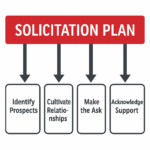Key Components of a Solicitation Plan

For philanthropy officers, a well-developed solicitation plan is the linchpin that turns thoughtful cultivation into tangible support. While many fundraisers focus heavily on relationship-building, the transition to asking for a gift requires a disciplined, strategic approach. Soliciting a major gift is rarely about one big ask—it’s the culmination of a deliberate plan that considers timing, players, messaging, and donor readiness.
Here are the essential components that every philanthropy officer should include in a solicitation plan:
1. Prospect Summary and Readiness Assessment
Begin with a succinct summary of the prospect, including:
- Giving history
- Affinity to your mission
- Recent engagement and interactions
- Philanthropic motivations
- Wealth indicators and estimated gift capacity
Confirm that the prospect has been adequately cultivated and is ready to be asked. Indicators of readiness include active engagement, positive responses to previous touchpoints, and expressions of interest in your work.
2. Solicitation Goal
Set a clear and realistic gift goal based on:
- Capacity and inclination
- Similar giving to your organisation or others
- Current campaign or programmatic needs
- Past giving behaviour (if applicable)
Be specific. Is the ask $25,000 for a scholarship fund, or $100,000 over three years for a capital campaign?
3. Gift Designation and Impact
Define exactly what the gift will support and how it aligns with the donor’s interests. Include:
- Project or fund designation
- Case for support specific to that initiative
- Quantified impact of the gift (e.g. “Your $50,000 will provide mentoring to 100 at-risk youth over two years”)
Personalising the impact helps the donor visualise the difference they will make.
4. The Ask Team
Determine who will participate in the solicitation:
- Primary solicitor (often the philanthropy officer)
- Organisational leader (e.g. CEO, Head of Programs)
- Peer solicitor (another donor or board member)
- Support staff (to manage logistics or follow-up)
Assign roles clearly, ensuring each person understands their contribution to the conversation.
5. Ask Method and Setting
Tailor the delivery method based on the donor’s preferences and the size of the ask:
- Face-to-face (ideal for major gifts)
- Zoom or phone (acceptable when geography limits in-person)
- Written proposal with follow-up call
- Formal event setting or private meeting
Choose a comfortable, non-threatening environment for the conversation—often at the donor’s office, home, or a neutral site.
6. Timing
Timing can make or break a solicitation. Consider:
- The donor’s personal calendar and financial planning cycle
- Organisational readiness to accept and manage the gift
- Campaign timelines or fiscal year deadlines
Avoid holidays or times when the donor may be distracted. Respect their rhythm.
7. Solicitation Materials
Prepare a tailored proposal or presentation that may include:
- A personalised case for support
- Financials or budget overview
- Recognition opportunities
- Tax deductibility and giving vehicles (e.g. donor-advised funds, bequests, multi-year pledges)
Avoid generic brochures—this is a high-touch, bespoke process.
8. Objections and Questions Anticipation
Map out possible donor concerns or objections, and prepare answers in advance:
- Why should I give this much?
- How will the money be used?
- How is the organisation financially managed?
- What if I want to give differently (structure, timing, etc.)?
Anticipating and addressing concerns builds trust and shows professionalism.
9. Recognition Strategy
Outline how the donor will be acknowledged if they give:
- Naming opportunities
- Public or private recognition
- Exclusive donor briefings or insider updates
- Stewardship plan (see separate blog post on that)
Recognition should be aligned with the donor’s preferences—not every donor wants their name on a wall.
10. Next Steps and Follow-up Plan
Plan what will happen after the solicitation, whether the donor says yes, no, or maybe:
- Who will follow up and when?
- How will you document the response?
- What will you send (thank-you letter, pledge form, updated proposal)?
- What are your internal processes for tracking the outcome?
Timeliness and professionalism post-ask are just as important as the ask itself.
Soliciting a major gift is not guesswork—it’s the outcome of thoughtful planning and precise execution. A strong solicitation plan gives the philanthropy officer—and the entire organisation—a roadmap to success. By focusing on the donor’s interests, setting clear objectives, and managing the process with professionalism, you can turn intent into action and relationships into meaningful investments.
